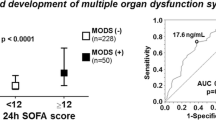Abstract
Objective
Heparin-binding protein (HBP) is a potent inducer of increased vascular permeability. The purpose of this study was to examine plasma levels of HBP in patients with shock.
Design
Fifty-three consecutive patients with septic and non-septic shock at a mixed-bed intensive care unit were included, as well as 20 age-matched controls. Patients with local infections but without signs of shock served as infectious controls. Enzyme-linked immunosorbent assay was used to determine plasma levels of HBP.
Results
There were no differences in serum HBP levels between healthy controls and those with local infections, including urinary tract infections, pneumonia and gastroenteritis, without shock. Levels of HBP were higher in patients with non-septic shock and septic shock than healthy controls. However, there was no difference in serum HBP levels between patients with septic shock and those with non-septic shock. Moreover, HBP levels were not different between patients with low and high APACHE II scores. Plasma levels of HBP were similar in surviving and non-surviving patients with shock.
Conclusions
HBP is elevated in patients with shock from septic and non-septic etiologies. Future investigations are required to define the functional role of HBP in patients with shock.


Similar content being viewed by others
References
Cohen J. The immunopathogenesis of sepsis. Nature. 2002;420:885–91.
Asaduzzaman M, Zhang S, Lavasani S, Wang Y, Thorlacius H. LFA-1 and Mac-1 mediate pulmonary recruitment of neutrophils and tissue damage in abdominal sepsis. Shock. 2008;30:254–9.
Rahman M, Zhang S, Chew M, Ersson A, Jeppsson B, Thorlacius H. Platelet-derived CD40L (CD154) mediates neutrophil upregulation of Mac-1 and recruitment in septic lung injury. Ann Surg. 2009;250:783–90.
Tapper H, Karlsson A, Mörgelin M, Flodgaard H, Herwald H. Secretion of heparin-binding protein from human neutrophils is determined by its localization in azurophilic granules and secretory vesicles. Blood. 2002;99:1785–93.
Gautam N, Olofsson AM, Herwald H, Iversen LF, Lundgren-Akerlund E, Hedqvist P, Arfors KE, Flodgaard H, Lindbom L. Heparin-binding protein (HBP/CAP37): a missing link in neutrophil-evoked alteration of vascular permeability. Nat Med. 2001;7:1123–7.
Soehnlein O, Zernecke A, Eriksson EE, Rothfuchs AG, Pham CT, Herwald H, Bidzhekov K, Rottenberg ME, Weber C, Lindbom L. Neutrophil secretion products pave the way for inflammatory monocytes. Blood. 2008;112:1461–71.
Chertov O, Michiel DF, Xu L, Wang JM, Tani K, Murphy WJ, Longo DL, Taub DD, Oppenheim JJ. Identification of defensin-1, defensin-2, and CAP37/azurocidin as T-cell chemoattractant proteins released from interleukin-8-stimulated neutrophils. J Biol Chem. 1996;271:2935–40.
Linder A, Christensson B, Herwald H, Björck L, Akesson P. Heparin-binding protein: an early marker of circulatory failure in sepsis. Clin Infect Dis. 2009;49:1044–50.
Bone RC, Balk RA, Cerra FB, Dellinger RP, Fein AM, Knaus WA, Schein RM, Sibbald WJ. Definitions for sepsis and organ failure and guidelines for the use of innovative therapies in sepsis. The ACCP/SCCM consensus conference committee. Chest. 1992;101:1644–55.
Dellinger RP, Carlet JM, Masur H, Gerlach H, Calandra T, Cohen J, Gea-Banacloche J, Keh D, Marshall JC, Parker MM, Ramsay G, Zimmerman JL, Vincent JL, Levy MM. Surviving sepsis campaign guidelines for management of severe sepsis and septic shock. Crit Care Med. 2004;32:858–73.
Bernard GR, Vincent JL, Laterre PF, LaRosa SP, Dhainaut JF, Lopez-Rodriguez A, Steingrub JS, Garber GE, Helterbrand JD, Ely EW, Fisher CJ Jr. Efficacy and safety of recombinant human activated protein C for severe sepsis. N Engl J Med. 2001;344:699–709.
Knaus WA, Draper EA, Wagner DP, Zimmerman JE. Prognosis in acute organ system failure. Ann Surg. 1985;202:685–93.
Påhlman LI, Mörgelin M, Eckert J, Johansson L, Russell W, Riesbeck K, Soehnlein O, Lindbom L, Norrby-Teglund A, Schumann RR, Björck L, Herwald H. Streptococcal M protein: a multipotent and powerful inducer of inflammation. J Immunol. 2006;177:1221–8.
Nakae H, Endo S, Inada K, Takakuwa T, Kasai T. Changes in adhesion molecule levels in sepsis. Res Commun Mol Pathol Pharmacol. 1996;91:329–38.
Silvestre J, Povoa P, Coelho L, Almeida E, Moreira P, Fernandes A, Mealha R, Sabino H. Is CRP a good prognostic marker in septic patients? Int Care Med. 2009;35:909–13.
Johansson J, Lindbom L, Herwald H, Sjöberg F. Neutrophil-derived heparin binding protein––a mediator of increased vascular permeability after burns? Burns. 2009;35:1185–7.
Berkestedt I, Herwald H, Ljunggren L, Nelson A, Bodelsson M. Elevated plasma levels of antimicrobial polypeptides in patients with severe sepsis. J Innate Immun. 2010;2:478–82.
Acknowledgments
This work was supported by grants from the Swedish Medical Research Council (2007-7480 and 2009-4872), Crafoord foundation, Einar and Inga Nilsson foundation, Harald and Greta Jaensson foundation, Greta and Johan Kock foundation, Fröken Agnes Nilsson foundation, Franke and Margareta Bergqvist foundation, Magnus Bergvall foundation, Mossfelt foundation, Nanna Svartz foundation, Ruth and Richard Julin foundation, Svenska Läkaresällskapet, MAS foundations, Scandinavian Society for Anesthesiology and Intensive Care Acta Foundation, Malmö University Hospital and Lund University. None of these funding bodies were involved in the study design, data collection, analysis, manuscript preparation or submission. We thank Monica Heidenholm for excellent technical assistance.
Conflict of interest
The authors declare that they have no competing interests.
Author information
Authors and Affiliations
Corresponding author
Additional information
Responsible Editor: Artur Bauhofer.
Rights and permissions
About this article
Cite this article
Chew, M.S., Linder, A., Santen, S. et al. Increased plasma levels of heparin-binding protein in patients with shock: a prospective, cohort study. Inflamm. Res. 61, 375–379 (2012). https://doi.org/10.1007/s00011-011-0422-6
Received:
Revised:
Accepted:
Published:
Issue Date:
DOI: https://doi.org/10.1007/s00011-011-0422-6




